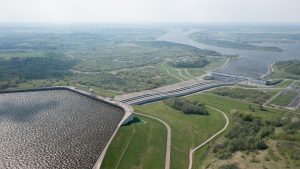Justin Rangooni, Executive Director of Energy Storage Canada, discusses Long-Duration Energy Storage, and how it is a necessity for a sustainable future that not only has the technology to create it, but the energy to power it.
After years of consistency, in the next three decades, Ontario’s energy sector and its electricity grid are expected to undergo a substantial transformation, which, of course, leaves a lot of room for innovation. While all types and technologies of energy storage are seeing substantial innovation in their composition and application, long-duration energy storage (LDES) is perhaps seeing more than others because there are far fewer instances of LDES assets having been deployed or connected to major grids, apart from pumped hydro.
LDES for the future
Yet, long-duration storage technologies are poised to be one of the critical technologies supporting the changes to Ontario’s grid as the province, like many regions, prepares to secure two or three times its current generating capacity and meet its ambitious decarbonisation goals. Changing the blend of resources supplying energy to the province, with an emphasis on non-emitting resources – including renewables like wind, solar, and hydro, new grid-scale and small modular nuclear assets, and emerging resources like hydrogen and geothermal – is going to be a major challenge. As we electrify heating and transportation, the frequently simultaneous demand for charging EVs or powering heat pumps is going to drive unprecedented levels of peak electricity demand that will compound the strain on our power grids.
As Ontario brings on more generation capacity and electricity demand reaches new levels, the province will require a greater variety of energy storage resources to ensure Ontario has the power it needs, when it needs it. Long-duration assets – broadly defined as assets capable of discharging energy for a period of ten or more hours – will be a key component of this mix. In fact, a recent report commissioned by Energy Storage Canada (ESC), and prepared by Dunsky Energy & Climate Advisors, identifies a minimum of six gigawatts (GW) of +10-hour duration energy storage starting in 2032, could mitigate potential supply, planning and deployment risks and achieve savings between $11bn–$20bn compared to Ontario’s current transition plans.
Policies to back it up
Fortunately, in recent years the Government of Ontario worked closely with the Independent Electricity System Operator (IESO) to adopt an ambitious approach to regulatory and market reforms to enable the deployment of energy storage resources (ESRs). The province achieved a major milestone last summer with the IESO’s procurement of over 880 MW of energy storage capacity, the largest in Canada – and as the initial stage of an ultimately 2,500 MW addition, one of the most ambitious such initiatives anywhere in North America. A 2022 report commissioned by ESC indicates the province could need as much as four to six gigawatts (GW) of short-duration storage – generally defined as assets capable of discharging energy for six hours or less – as part of Ontario’s path to net zero.

Pumped hydro is an example of Long-Duration Energy Storage
Energy storage resources (ESRs) are important for Ontario’s future grid because they can all, regardless of duration, intake power during times of high generation, store it, and then discharge that power to the grid at periods of high demand. This alleviates stress on the system and reduces costs. ESRs comprise a wide range of technologies, durations, and lifespans, from familiar hydroelectric dams to lithium-ion batteries and a wide array of emerging designs like compressed air and molten salt. These assets will be essential in reducing incidences of surplus baseload generation (SBG) – moments when the province’s power resources are generating more than can be consumed or economically exported – ensuring that electricity can be used to power the province’s growing, energy-intensive industrial and natural resources sectors. These grid-scale batteries will also act as ‘Non-Wires Alternatives’ (NWAs), relieving transmission constraints at a fraction of the cost – and time – of constructing traditional poles and wires expansions.
Collectively, batteries and other energy storage resources are helping reduce the need for natural gas-fired generation capacity and accelerating the pace at which the province can achieve an emissions-free power system. Most energy storage resources are also capable of supporting the provincial grid during extreme weather events, including ‘black-start’ functionality that can bring the lights back on in the event of a system-wide power outage. However, as Ontario brings on more non-emitting generation, particularly intermittent resources (such as wind or solar), and peak demand reaches new levels, the province will need a more substantial inventory of LDES resources to ensure its grid continues to be reliable when the wind isn’t blowing, and the sun isn’t shining.
Energy Storage Canada’s report is the first to go beyond speculating the potential use cases for LDES technologies to research the potential scope of investment for Ontario as the province decarbonises, with new modelling from Dunsky Energy & Climate Advisors, which illustrates the specific advantages that investment in LDES assets can provide.
Challenges ahead
Using the IESO’s Pathways to Decarbonization (P2D) study from December 2022 as a baseline, Dunsky analysed the likeliest risks in those scenarios, quantifying the cost of falling short in our planning, procurement, construction, and import objectives compared to the alternative cost of procuring LDES assets. Evaluating the technical readiness and value proposition of LDES as a ‘guardrail’ for Ontario’s economic growth and decarbonisation journey, Dunsky found that a minimum of six GW of LDES capacity would be economically beneficial starting in 2032.
However, compared to most short-duration energy storage technologies procured in Ontario to date, LDES technologies generally have long lead times for development, meaning that to ensure the assets are available when we need them, we need to start planning now. Again, Ontario is making progress ahead of many other regions in acknowledging the importance of looking ahead if the province is to capitalise on LDES technologies. Last month, the province’s Minister of Energy, Todd Smith, issued a letter to the IESO instructing them to continue working with proponents of the province’s most advanced LDES initiatives, the pumped hydro 1,400 MW Meaford and 400 MW Marmora projects.

Salt caverns can be used to store energy in the form of gas, such as hydrogen
As Dunsky’s report makes clear, the development of these two projects should just be the start of a much larger capacity addition over the next decade. As the province’s grid undergoes a massive transformation and modernisation in the coming decades to meet its energy needs, integrating new assets in new ways, the importance of pursuing innovative solutions and technologies, such as long-duration energy storage, will become increasingly important. While 2032 is eight years away, the time to act is now.
What needs to be done
To that end, Energy Storage Canada is calling on the IESO to make a formal commitment this year to initiating a procurement process in 2025, with a six GW target. Critical factors such as the availability of Canada’s Clean Technology Investment Tax Credits (ITCs) for projects completed prior to 2032, the extensive lead time necessary for prospective proponents to develop positive relationships with Ontario municipalities, to develop equitable and beneficial partnerships with the province’s First Nations communities, and secure supply chain commitments in a competitive global market, all demonstrate the need to begin the process now.
Energy Storage Canada and our members look forward to continuing the work with the Ministry of Energy and the IESO to further develop the innovative research related to long duration energy storage, and all storage technologies. The integration of LDES has the potential to build on Ontario’s energy storage advantage, ensuring the province continues to have a reliable, sustainable, and flexible energy supply in the decades to come.
Please note, this article will also appear in the seventeenth edition of our quarterly publication.









